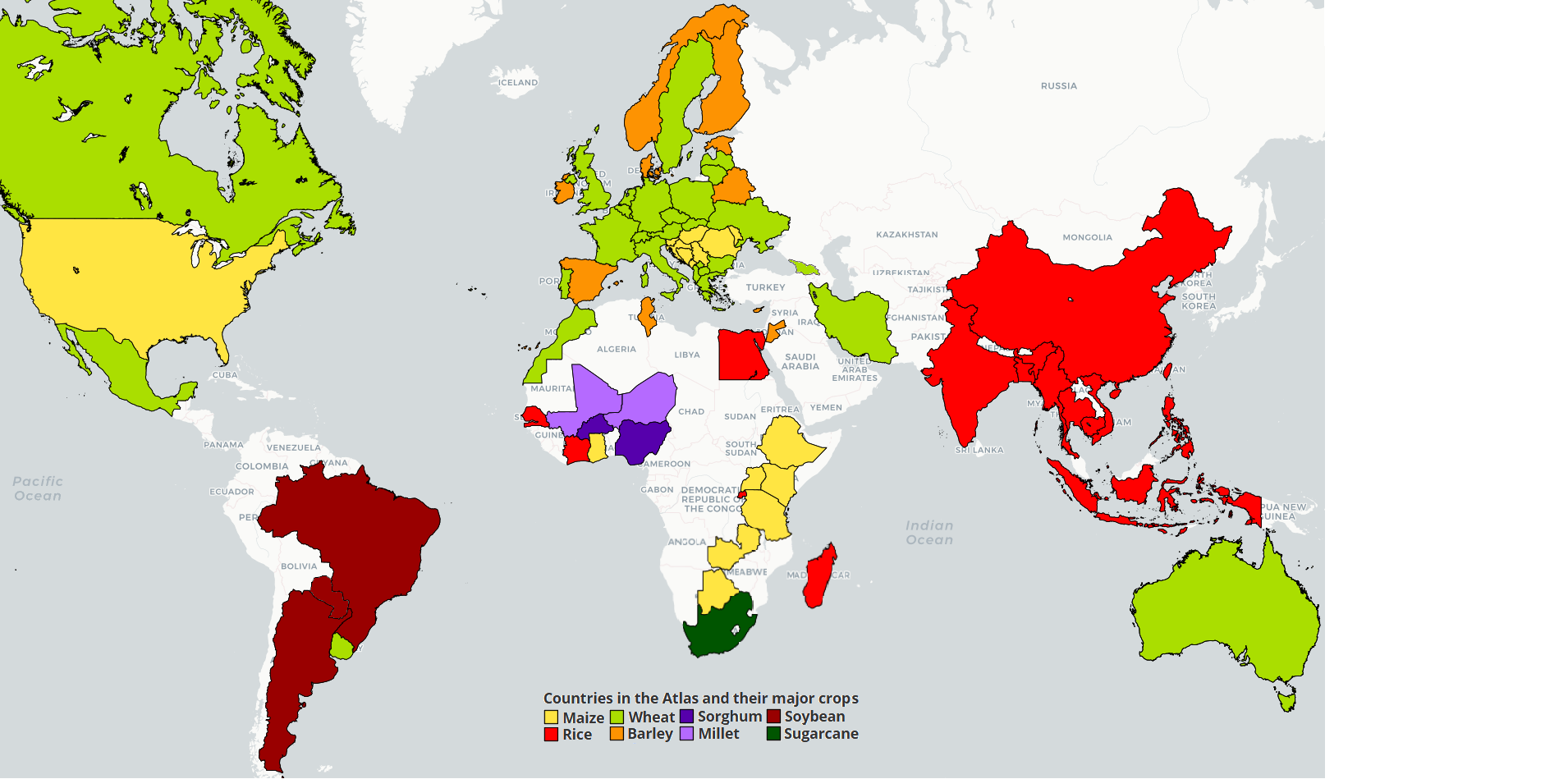 Australia
Australia
Description of cropping systems, climate, and soils
Wheat production in Australia accounts for 55% of the total cropland, averaging 12.7 million ha over the 15 seasons from 2003 to 2017 (ABARES, 2022). Over the same period, the wheat crop area has declined by an average 1.1% per year, but production has fluctuated between 10.8 Mt in 2006 and 31.8 Mt in 2016. Globally, Australian wheat averaged approximately 3.5% of world production over the same period, and 12.1% of global wheat exports (2005-2012). Canola production in Australia averaged 2.0 million ha over the 15 seasons from 2003 to 2017 (ABARES, 2022). Over the same period, the canola crop area has increased by an average 3.4% per year, but production has fluctuated between 0.57 Mt in 2006 and 4.31 Mt in 2016.
Wheat crops are commonly grown in rotation with break crops such as pulses, canola, barley, oats and sorghum. Wheat is also grown in crop-pasture rotations and a small but increasing number of wheat crops are grazed during their vegetative phase. A survey of farm practices with 1312 grain producers found that in 2011, the average farm size was 3810 ha. On average 61% was cropped, 33% was maintained as pasture and 5% was reported as native vegetation. Of the cropped area, 58% was planted to wheat, 14.5% to barley, 4.3% to other winter cereals and 3.6% to summer cereals. 9.6% of the cropped area was planted to winter oilseeds and 6.8% to pulses. More than 75% of the cropped area was planted where a crop was present in the preceding year. The percentage of the crop planted using zero or no-tillage was 60%. The use of controlled traffic was 20%. A similar area has been yield-mapped but only 10% of the area used variable rate technologies (GRDC 2012).
Table 1. Australian wheat and canola harvested areas, average yields and total production over 15 seasons (2003 to 2017). Source: (ABARES, 2022).
| Year | Wheat Area | Wheat Yield | Wheat Production | Canola Area | Canola Yield | Canola Production |
| '000 ha | t/ha | kt | '000 ha | t/ha | kt | |
| 2003 | 13067.1 | 1.999816 | 26131.8 | 1210.60 | 1.41 | 1702.35 |
| 2004 | 13399.4 | 1.634782 | 21905.1 | 1377.06 | 1.12 | 1542.32 |
| 2005 | 12442.6 | 2.021314 | 25150.4 | 971.69 | 1.46 | 1418.94 |
| 2006 | 11797.9 | 0.917256 | 10821.7 | 1051.82 | 0.55 | 573.32 |
| 2007 | 12578.2 | 1.078803 | 13569.4 | 1277.08 | 0.95 | 1214.37 |
| 2008 | 13530.2 | 1.583133 | 21420.1 | 1692.61 | 1.09 | 1844.16 |
| 2009 | 13881.1 | 1.57293 | 21834 | 1694.94 | 1.13 | 1907.27 |
| 2010 | 13501.8 | 2.0301 | 27410 | 2077.52 | 1.14 | 2358.72 |
| 2011 | 13902.14 | 2.151108 | 29905.01 | 2460.79 | 1.39 | 3427.29 |
| 2012 | 12979.23 | 1.760903 | 22855.17 | 3271.50 | 1.27 | 4141.59 |
| 2013 | 12613.08 | 2.006069 | 25302.71 | 2720.68 | 1.41 | 3831.91 |
| 2014 | 12383.67 | 1.917247 | 23742.56 | 2896.95 | 1.22 | 3540.02 |
| 2015 | 11282.2 | 1.974306 | 22274.51 | 2090.89 | 1.33 | 2775.48 |
| 2016 | 12191.15 | 2.609986 | 31818.74 | 2681.16 | 1.61 | 4313.23 |
| 2017 | 10919.18 | 1.91783 | 20941.13 | 3171.12 | 1.23 | 3893.07 |
| Average | 12697.93 | 1.811706 | 23005.49 | 2043.10 | 1.22 | 2565.60 |
Compared to Midwestern America and Europe, only one tenth to half the amount of fertilizer and agrichemicals are used per hectare of cropland (Price 2006). A defining characteristic of Australian agriculture is that it is predominantly a low input, low output system, where labour efficiency is extremely high (ABS 2010; Hochman et al., 2013; Giller et al. 2021).
Australia is known for a variable climate and highly variable rainfall which results in substantial variation in crop yields. For example, average wheat yield nationally in 2006 was 0.92 t/ha, whereas in 2016 it was more than double that at 2.61 t/ha (Table 1).
Average annual rainfall in Australia ranges widely, with some areas receiving less than 200 mm while other areas average over 3200 mm. Rainfall is generally higher towards the coast, and is influenced by elevation, with mountain areas in northeastern Queensland, southeastern Australia and western Tasmania receiving higher rainfall totals. In the northern areas of Australia, most rainfall is associated with monsoonal patterns and occurs in the summer months. Wheat is primarily a winter crop and is mainly grown in southern Australia where most rain falls during the winter months. The majority of wheat cropping is located in areas receiving between 300 mm and 600 mm annually, with 46% receiving 300–400 mm, 24% receiving 400–500 mm and 17% receiving 500-600 mm. Only 4% of wheat cropping occurs in drier areas, and 9% in wetter areas (600-800 mm) (ABARE-BRS, 2010; BoM, 2009).
The major soils in the wheat cropping areas are shown in Table 2. Australian Soil Classifications (ACLEP, 2012) were used as the basis for crop yield simulations, and Soil Taxonomy Order equivalents are provided for comparison.
Table 2: Australian Soil Classification and Soil Taxonomy Order (Isbell, 1996) of major soils in the wheat cropping areas.
| Australian Soil Classification (ACLEP, 2012) | Soil Taxonomy Order | % of area |
| Vertosols | Vertisols | 23% |
| Sodosols | Alfisols, Aridisols | 20% |
| Calcarosols | Aridisols, Alfisols | 16% |
| Chromosols | Alfisols, some Aridisols | 15% |
| Kandosols | Alfisols, Ultisols, Aridisols | 12% |
Data Sources and Assumptions (following GYGA protocols)
Yield gap calculations are based on 15 years of data (2003-2017). This period is long enough to account for climate variability but short enough not to be substantially affected by technology change and climate change. However, the years 2003 to 2009 were part of the millennial drought, one of the driest periods on record in Australia.
Harvested area and actual yields
The Australian Bureau of Statistics (ABS) collates national agricultural data at the level of Statistical Area 4 (SA4) annually, and at the finer scale of Statistical Area 2 (SA2) every five years when a census is carried out. These statistical areas are part of the Australian Statistical Geography Standard (ASGS) that the ABS adopted for publications from the year 2010. Prior to that, production data was published at Statistical Division (SD) yearly and at Statistical Local Area (SLA) every five years, based on the previous Australian Statistical Geographical Classification (ASGC). Note that the boundaries of these statistical areas are based on population, so they are updated periodically. SA2s are medium-sized general-purpose areas built to represent communities that interact together socially and economically, with a typical population range of 3,000 to 25,000 people. In contrast, SA4s are designed for the output of regional data and have a population of over 100,000 people. SA2s fit neatly within SA4s, and their boundaries coincide perfectly. Our reference areas correspond to the 2010 version of SA4s and SA2s.
Data on annual crop harvested area and average yields for the years 2003 to 2010 were sourced from ABS (2012) at SLA level for census years (2001, 2006) and at SD level for intervening years up to 2009. The data prior to 2010 was manipulated to fit the SA2 and SA4 polygons based on the intersection between SA2s and SLAs. From 2010 to 2017, for years where only SA4 level data were available, crop yields (t/ha) were downscaled from SA4 to SA2 level based on the average SA4 to SA2 yield ratio for Agricultural Census years after the Australian Statistical Geography Standard (ASGS) was introduced (i.e. the years 2010 and 2015).
Spatial datasets showing the location of specific crop types (such as wheat) are not available at a national scale. The most suitable dataset is the ABARE-BRS (2010) National Land Use of Australia version 4 (2005-6) available at http://www.daff.gov.au/abares/aclump/pages/land-use/data-download.aspx. This provides a ‘cereals' land use class of 20,812,366 ha which was used to indicate the distribution of wheat cropping. Making a simplifying assumption that wheat comprised a fixed proportion (59.79%) of cereal cropping over the entire mapped cereals area, those areas were adjusted to the 2005/6 wheat area of 12,443,000 ha (ABARES, 2012).
Weather data and reference weather stations
The Australian Bureau of Meteorology (BoM) manages a network of meteorological stations for which daily data are available. Within the wheat zone, 19 BoM stations were available which have maintained an ongoing rainfall, temperature and evaporation data for at least the previous 20 years and which we used as the primary meteorological stations. In addition data for 2562 Patched Point Dataset (PPD) sites were used as secondary meteorological stations. PPD stations are those at which only limited variables are recorded (e.g. only rainfall) or provide incomplete temporal coverage. The PPD station data comprise of actual recorded observations where available, and are in-filled with interpolated data (Jeffrey et al., 2001) to cover missing periods and attributes. Daily solar radiation data were sourced from BoM satellite derived daily data (https://www.longpaddock.qld.gov.au/silo/about/data-updates/ ). The daily weather data used in our wheat and canola simulations may be accessed from: https://www.longpaddock.qld.gov.au/silo/point-data/ .
Following the GYGA protocol (van Wart et al., 2013a), we selected six Global Yield Atlas Extrapolation Domain (GYGA-ED; van Wart et al., 2013b) agro-climatic zones (CZs) each of which contain at least 5% of the national cereals cropping area (Table 3), and which together cover 78.8% of the total cropping area. Within these six CZs, 22 reference weather stations (RWS) were selected using a Python geoprocessing script run in ArcGIS (Environmental Systems Research Institute, 2010). The script iteratively selected RWS from lists of candidate meteorological stations as follows. The primary meteorological stations were used as the first set of candidates, then the list of secondary stations:
- Each candidate meteorological station was allocated a ‘buffer zone' defined by a 100 km radius, and which was clipped to the boundary of the CZ in which each station is located.
- The station with the largest area of cereal cropping within its buffer zone was added to the list of selected RWS.
- Eliminate any candidate stations if their buffer overlaps those of selected RWS by more than 25%.
- Repeat steps 1 to 3 until no more candidate stations are available.
The combined cropped areas within the 22 RWS buffer zones covered 50% of the national cereals area. Actual yields (Ya) were allocated to each RWS based on annual yield data from SLAs covered by the RWS buffer zones. Each RWS buffer zone partially or wholly covers more than one SLA. The contribution of each SLA to the Ya of a buffer zone was therefore weighted by its ‘cereal' land use area within that zone.
Table 3. Proportion of national cereals area covered by the six selected GYGA-ED zones.
| GYGA-ED Zone (CZ) | % of cereals area |
| 5102 | 15.0% |
| 5202 | 5.6% |
| 6002 | 25.8% |
| 6102 | 17.4% |
| 6202 | 6.7% |
| 7102 | 8.4% |
| Total | 78.8% |
Soil data
For water-limited yield potential simulation we relied on characterized soils from the APSoil database (http://www.apsim.info/Wiki/APSoil.ashx; Dalgliesh et al., 2009). In order to select suitable characterized soils for cropping simulations, ArcGIS analysis tools were used to summarize the area of cropped soils within each RWS buffer zone using national soil grids (ACLEP, 2012). Based on these summaries, three soil types were selected within or as close as possible to each RWS buffer zone which matched, as best as possible, Australian Soil Classification (ASC) order, texture, plant available water capacity (PAWC) and bulk density of the three main soils within the RWS buffer zone.
Crop system and management information for crop simulations
Water-limited yield potential was simulated using the APSIM (Version 7.4 for wheat and version 7.1 for canola simulations; http://www.apsim.info/Wiki/Downloads.ashx; Keating et al., 2003; Holzworth et al., 2014) modelling framework. APSIM is a daily time-step cropping systems simulator that incorporates meteorological data, crop growth and soil water and nutrient models. APSIM is well validated for Australian wheat crops (e.g. Hochman et al., 2009; Carberry et al., 2013) and has been partially ground tested for yield gap assessment (e.g. see Hochman et al., 2012). A large number of wheat varieties are parameterized for APSIM, and the model allows sowing and fertilizer rules to be flexibly specified.
Since starting soil moisture conditions at each site were unknown, values were arbitrarily set for 1981 and continuous wheat- summer fallow- wheat and canola- summer fallow– canola simulations were run from 1981 to 2017. Cycling through a sequence of crops experiencing wetter and drier seasons and fallows, causes soil moisture to self-correct over a few seasons. This cautious approach enabled the simulated soil moisture conditions to stabilize over 22 years of simulations from 1981 to 2002.
Wheat and canola varieties
Five wheat varieties (Mace, Scout, Derrimut, Endure and Bolac) and three canola varieties (fast spring hybrid, mid spring hybrid and slow spring hybrid) representing progressively slower maturity types, were simulated for each soil type and RWS to examine which are best suited to each RWS. After sowing and fertilizer application rules were applied, the simulated yields of the variety which produced the highest average yields for each site over the 15 year period (2003-2017) was chosen to represent Yw.
Wheat sowing rule
Two different sowing rules based on local expertise were used depending on the RWS region. For northern sites (n=9) the rule was set as follows:
Sow if at least 10 mm or more of rainfall over 3 days and PAW>=30 mm from 26 April-15 July
For western and southern sites (remaining sites)
Sow if at least 10 mm or more of rainfall over 3 days regardless of soil moisture from 26 April-15 July
If the above criteria were met, the amount of soil moisture in the top 30cm of the soil profile was determined and the crop was sown if PAW < 95% PAWC. If PAW >= 95% PAWC in the top 30cm of the soil it was considered too wet to sow and sowing was delayed until PAW < 95% PAWC. For all site simulations the crop was sown on 15th July if the above criteria were not met during the sowing window. Sowing density was 150 plants m-², row spacing was 0.25 m and sowing depth was 3 cm.
Canola sowing rule
At all sites, canola was sown using the Unkovich (2010) sowing rule i.e., canola was sown if the sum of rainfall over a 7-day period exceeded pan evaporation over the same period from 1 April to 15 July. For all site simulations the crop was sown on 15th July if the sowing criteria were not met during the sowing window. Sowing density was 40 plants m-², row spacing was 0.18 m and sowing depth was 2 cm.
Wheat Fertilizer rule
Unlike with some other crop models, it is not possible to turn the nitrogen module off in APSIM in order to simulate a nutrient unlimited yield. This is because there are many dependencies between the soil N and soil water and surface OM modules. Without the N module residue breakdown will be affected which in turn would affect the water balance. Instead we use fertilizer application rules (see rules below) that ensure that there is at least 50 kg/ha N in the top 60 cm up to the ‘first awns visible' growth stage. This means that soil N rarely limits crop yield. You can still have N stress but it is due to lack of soil water where the soil nitrogen is plentiful. This rule is sensitive to the problem of ‘haying off' - a situation where excessive vegetative growth leads to lower yields when water stress occurs during grain-filling. After experimenting with variations to the fertilizer rules with higher rates of N, we are confident that these rules result in the best estimate of water limited and N unlimited wheat yields:
At sowing, add 100 kg/ha NO3 minus soil nitrate in top 60 cm of soil on April 25th
Check top 60 cm soil daily, if NO3<80 kg/ha and PAW>30 mm and Zadok growth stage < 49 then add 70kg N/ha
Canola Fertilizer rule
At sowing, add 250 kg/ha NO3 minus soil nitrate in top 60 cm of soil on March 31st
Check top 60 cm of soil at floral initiation, if NO3<400 kg/ha then add 100kg N/ha
Frost and Heat Stress
For wheat simulations, frost and heat stress functions were used to reduce yield as described by Hochman and Horan (2018) using Frost and Heat 2 rules. This was halving the effect described in Bell et al (2015).
Mild frost: for each day when growth stage is > = Z60 (first flower) and < Z69 (100% flowering), and daily minimum temperature <= 2 °C and > 0 °C, the yield potential is reduced by 5%
Moderate frost: for each day when growth stage is > = Z60 and < Z75 (mid-milk), and daily minimum temperature <= 0 °C and > −2 °C, the yield potential is reduced by 10%
Severe frost: for each day when growth stage is > = Z60 and < Z79 (end of grainfilling), and daily minimum temperature <= −2 °C, the yield potential is reduced by 45%
Mild Heat: for each day when growth stage is > = Z60 and < Z79, and daily maximum temperature >= 32 °C and < 34 °C, the yield potential is reduced by 5%
Moderate Heat: for each day when growth stage is > = Z60 and < Z79, and daily maximum temperature >= 34 °C and < 36 °C, the yield potential is reduced by 10%
Severe Heat: for each day when growth stage is > = Z60 and < Z79, and daily maximum temperature >= 36 °C, the yield potential is reduced by 15%
A similar set of functions was applied for canola simulations to reduce yield due to frost and heat stress during critical growth phases.
Potential yield (Yp) estimation
To estimate potential yield in the absence of moisture constraints, the APSIM simulations used for Yw (as described above) were modified to reset soil water to 95% drained upper limit at the start of each day of the simulations. Additionally, to ensure that abundant soil nitrate was available, soil N levels were reset at the start of each day. In this way, crops were simulated as though fully irrigated. For wheat simulations, all maturity types were sown on 26 April and the cultivar with the highest average yield over the 15-year period (2003-2017) was chosen to represent Yp. For canola simulations, the slowest maturity type was sown on 16 April, 26 April and 6 May with the sowing date producing the highest average yield over the 15-year period (2003-2017) chosen to represent Yp.
References:
ABARE-BRS (2010). Land Use of Australia, Version 4, 2005-06. Australian Bureau of Agricultural and Resource Economics - Bureau of Rural Sciences (ABARE-BRS). Australian Collaborative Land Use and Management Program (ACLUMP).
ABARES (2012). Agricultural commodity statistics 2012. Canberra: Australian Bureau of Agricultural and Resource Economics and Sciences.
ABARES (2022). Agricultural commodity statistics 2022. Canberra: Australian Bureau of Agricultural and Resource Economics and Sciences.
ABS, 2010. Agricultural Commodities, 2008-09, Australia Australian Bureau of Statistics Catalogue No. 7121.0, Canberra.ABS (2012). Agricultural Census: Value of Agricultural Commodities. Australian Bureau of Statistics.
ACLEP (2012). Australian soil classification (ESRI Grid). Australian Collaborative Land Evaluation Program (ACLEP) endorsed through the National Committee on Soil and Terrain (NCST).
Bell, L.W., Lilley, J.M., Hunt, J.R. and Kirkegaard, J.A. (2015) Optimising grain yield and grazing potential of crops across Australia’s high-rainfall zone: a simulation analysis. 1. Wheat, Crop & Pasture Science, 66, 332-348.
BoM (2009). Mean annual rainfall data (base climatological data sets). Commonwealth of Australia (Bureau of Meteorology).
Carberry, P. S., Liang, W.-l., Twomlow, S., Holzworth, D. P., Dimes, J. P., McClelland, T., Huth, N. I., Chen, F., Hochman, Z. & Keating, B. A. (2013). Scope for improved eco-efficiency varies among diverse cropping systems. Proceedings of the National Academy of Sciences 110(21): 8381-8386.
Dalgliesh, N. P., Foale, M. A. & McCown, R. L. (2009). Re-inventing model-based decision support with Australian dryland farmers. 2. Pragmatic provision of soil information for paddock-specific simulation and farmer decision making. Crop and Pasture Science 60(11): 1031-1043.
ESRI (2010). ArcGIS 10.0. Redlands, CA: Environmental Systems Research Institute.
Giller, K.E., Delaune, T., Silva, J.V. et al. The future of farming: Who will produce our food?. Food Sec. 13, 1073–1099 (2021). https://doi.org/10.1007/s12571-021-01184-6
Hochman Z, PS Carberry, MJ Robertson, DS Gaydon, LW Bell, PC McIntosh. 2013. Prospects for ecological intensification of Australian agriculture. European Journal of Agronomy, 44, 109-123.
Hochman, Z., Gobbett, D., Holzworth, D., McClelland, T., van Rees, H., Marinoni, O., Navarro Garcia, J. & Horan, H. (2012). Quantifying yield gaps in rainfed cropping systems: an Australian case study Field Crops Research 136: 85-96.
Hochman, Z., Holzworth, D. & Hunt, J. R. (2009). Potential to improve on-farm wheat yield and WUE in Australia. Crop and Pasture Science 60(8): 708-716.
Hochman, Z. and Horan, H. (2018) Causes of wheat yield gaps and opportunities to advance the water-limited yield frontier in Australia. Field Crops Research 228 (2018) 20–30.
Holzworth, D.P., Huth, N.I., et. al. 2014. APSIM–evolution towards a new generation of agricultural systems simulation. Environmental Modelling & Software 62: 327–350.
Isbell, R. F. (1996). Australian Soil and Land Survey Handbook: The Australian Soil Classification. CSIRO Australia.
Jeffrey, S. J., Carter, J. O., Moodie, K. B. & Beswick, A. R. (2001). Using spatial interpolation to construct a comprehensive archive of Australian climate data. Environmental Modelling & Software 16(4): 309-330.
Keating, B.A., Carberry, P. S., Hammer, G. L., Probert, M. E., Robertson, M. J., Holzworth, D., Huth, N. I., Hargreaves, J. N. G., Meinke, H., Hochman, Z., McLean, G., Verburg, K., Snow, V., Dimes, J. P., Silburn, M., Wang, E., Brown, S., Bristow, K. L., Asseng, S., Chapman, S., McCown, R. L., Freebairn, D. M. & Smith, C. J. (2003). An overview of APSIM, a model designed for farming systems simulation. European Journal of Agronomy 18(3–4): 267-288.
Price, G.H., 2006. Plant nutrients in the Environment (Table 10.1, Chapter 10). In: Australian Soil Fertility Manual, 3rd ed. CSIRO. Melbourne, 176 pp.
Unkovich, M. (2010) A simple, self adjusting rule for identifying seasonal breaks for crop models. Proceedings of the 15th ASA Conference ‘Food Security from Sustainable Agriculture’ Lincoln, New Zealand, 15-19 November 2010.
van Wart, J., Kersebaum, K. C., Peng, S., Milner, M. & Cassman, K. G. (2013a). Estimating crop yield potential at regional to national scales. Field Crops Research 143(0): 34-43.
van Wart, J., van Bussel, L. G. J., Wolf, J., Licker, R., Grassini, P., Nelson, A., Boogaard, H., Gerber, J., Mueller, N. D., Claessens, L., van Ittersum, M. K. & Cassman, K. G. (2013b). Use of agro-climatic zones to upscale simulated crop yield potential. Field Crops Research 143: 44-55.
 Download GYGA results
Download GYGA results
 Country agronomists
Country agronomists

Zvi Hochman
Project leader, Agronomist
http://www.researcherid.com/rid/E-8993-2010

David Gobbett
GIS and data analysis
http://www.researcherid.com/rid/F-8910-2010

Heidi Horan
Cropping systems simulation

Di Prestwidge
Data management and analysis
http://www.researcherid.com/rid/D-3392-2011

Javier Navarro Garcia
Systems modelling and Data analysis

Julianne Lilley
Crop physiologist / modeller
http://www.researcherid.com/rid/A-1399-2010

